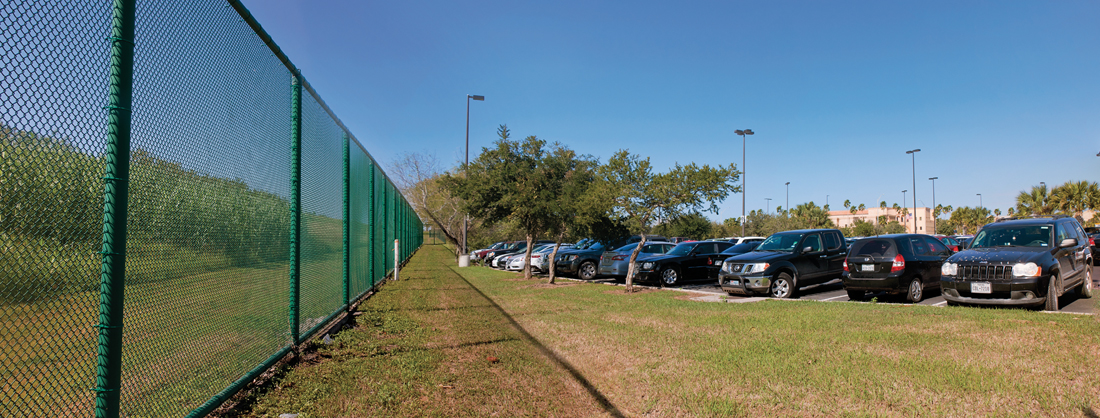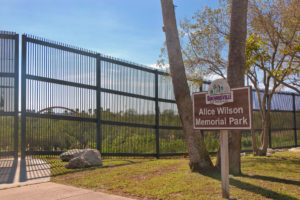
President Donald Trump has signed an executive order that calls for the construction of a wall along the southern border, and that could potentially affect UTRGV, which already has the Border Fence running through part of its campus in Brownsville.
Trump’s first order, “Border Security and Immigration Enforcement Improvements,” calls for the “immediate construction of a physical wall on the southern border, monitored and supported by adequate personnel so as to prevent illegal immigration, drug and human trafficking, and acts of terrorism.”
Then-President George W. Bush signed the Secure Fence Act into law in 2006. The act allowed the U.S. Department of Homeland Security to “take all actions the secretary determines necessary and appropriate to achieve and maintain operational control over the entire international land and maritime borders of the United States.”
In Fall 2007, Homeland Security sent a letter to University of Texas at Brownsville and Texas Southmost College President Juliet V. García, asking her to allow the agency to survey university land for 18 months for the possible construction of the fence.
The agency also stated in its letter that it would not be responsible for any damage done during that time by its activities and should it determine need for any university land, the university would be paid market value for the land, according a report published in the university’s student newspaper, The Collegian.
García refused to sign the letter. Her reasons for refusing to sign the letter included the following:
–A risk to property investment
–The fence would jeopardize campus security
–Building the fence structure would have a negative impact on the environment
The debate led to the U.S. government filing a lawsuit against the university on Feb. 8, 2008, to access the campus for surveying.
In March 2008, U.S. District Judge Andrew Hanen dismissed the border-fence lawsuit after a settlement was reached by the parties.
Part of the settlement reached with Homeland Security called for UTB/TSC to begin construction of a campus fence. The fence cost the UT System $1.4 million.
In August 2015, UTB merged with UT Pan American to become UTRGV.
The Rider tried contacting UTRGV Provost Havidán Rodríguez to ask how the university would respond if something similar were to happen on its Brownsville campus because of Trump’s executive order. The newspaper was referred to Patrick Gonzales, the university’s assistant vice president of Marketing and Communications.
“We’re not going to answer any questions that are speculative,” Gonzales said. “Once the decision of the border wall is made, once we find out details of where it’s going to be, I’m sure we’ll be involved in those discussions. … We don’t want to answer speculations.”
Trump’s executive order, signed last Wednesday, defines “wall” as a “contiguous, physical wall or other similarly secure, contiguous, and impassable physical barrier.”

An executive order is a directive issued by the president that directs federal agencies to, essentially, do certain things or to implement the law in a particular way, said Mark Kaswan, a UTRGV political science professor.
“Because it is a directive by the president, essentially, it’s a set of instructions to federal agencies to do certain things,” Kaswan said about the process to execute an order. “It is generally going to be to do certain things. You might have an executive order telling a federal agency not to do certain things. For example, President Obama’s [Deferred Action for Childhood Arrivals] … instructed immigration agents not to deport certain classes of immigrants. So, in that sense, it could include telling federal employees not to do certain things. But, generally it’s essentially instructing members of the executive branch what they should do and it carries the force of law within the executive branch.”
Kaswan said Congress has no authority over executive orders. It can try to undermine an executive order by passing a law, but it could become problematic.
“In order for the law to be enacted, the president has to sign it and so, the president is unlikely to sign a law that undoes an executive order since [he is] the one who issued the executive order,” he said. “The only time when they might do that is that Congress has tricky ways of embedding certain things into legislation that the president pretty much has to sign. For that reason, the president might sign a law, but, in general, Congress finds it very difficult to undermine an executive order.”
Asked who can stop a president’s executive order, Kaswan replied that courts can.
“The courts can invalidate an executive order if it finds that the order violates the law or if it violates the Constitution; that can be done by a judge at any level in the federal system, so a district court judge, which is the lowest level, can invalidate an executive order,” he said. “It doesn’t have to go to the Supreme Court. Oftentimes, it will go to the Supreme Court, but it can be done by a judge at a lower level. In fact, we had an example of that a couple of years ago … when a federal judge here in Brownsville ruled that one of President Obama’s immigration-related executive orders, one that was called [Deferred Action for Parents of Americans], was unconstitutional.”
Last Thursday, Mexican President Enrique Peña Nieto canceled his meeting with Trump, which was scheduled for Tuesday, over disagreements about who would pay for construction of the proposed wall along the U.S.-Mexico border.
“This morning we have informed the White House that I will not attend the meeting scheduled for next Tuesday with the @POTUS,” Peña Nieto tweeted in Spanish.
Trump addressed the canceled meeting with Peña Nieto during the Congressional GOP Retreat in Philadelphia later that day.
“Unless Mexico is going to treat the United States fairly, with respect, such a meeting would be fruitless, and I want to go a different route. We have no choice,” Trump said during the retreat.
U.S. Rep. Filemon Vela (D-Texas) told The Rider on Friday his views about Trump’s wall have not changed since the letter he sent to him last summer.
“We’re building [a wall] on the border with a country that’s an ally, not an enemy; it’s just absurd,” Vela said. “It just makes things worse and worse. What’s really astonishing to me is that you have on one hand Vladimir Putin, who’s stealing American secrets. [Trump has] this supposedly cordial relationship with [him]. On the other hand, when he’s dealing with a country that is our third largest trading partner, he’s taking this antagonistic approach. It’s really baffling.”
In his letter, Vela calls Trump a racist and writes: “you can take your border wall and shove it up your ass.”
Asked what he and the rest of Congress are going to do regarding Trump’s executive order, Vela replied: “Right now, we haven’t even organized our congressional committees. We have our first organizational meetings [this] week and, in Homeland Security, I suspect that Republicans will bring up a border security bill sometime in the next month or so and, you know, the devil is going to be in the details. There will likely be provisions to support Trump’s wall and we’re just going to have to fight it tooth and nail and hope that we can defeat it in the House. It’s kind of hard to say because they haven’t given us a proposed bill.”
Nursing freshman Linda Soto said building the wall is a waste of money.
“It’s not going to cost [Trump], of course. … It’s going to cost, mostly, the middle class and to be honest, they’re the ones that voted for him because they’re the ones that wanted change,” Soto said. “They wanted change and, apparently, it’s going to cost their pockets for the change. … There’s already a wall. What, is he ‘reinforcing’ it? People are going to find a way over it, under it, whichever way they can. To be honest, it’s just a waste of money and it’s not going to be a pretty view.”
Kaswan said the diplomatic dispute between Trump and Peña Nieto is “horrible” for the U.S.-Mexico relationship.
“It’s very destructive,” he said. “As you know, Trump started that by telling Peña Nieto that he shouldn’t bother to come if he’s not willing to pay for the wall. So, Trump, it seems like, has little regard or respect for international norms of the way that countries should relate to one another and to treat our southern neighbor in that way, a country with which we do huge volumes of trade, whose economy, I mean, the well-being of the Mexican economy is very important for the well-being of the U.S. economy. … Mexico is one of the biggest trading partners with the United States. We don’t just import from Mexico; we export to Mexico.”
Kaswan said Mexico is an important partner for the country.
“As Trump seems to be aware of, they’re an important partner in terms of national security as well. To start off a relationship on such a bad foot really seems to be moving in a troubling direction that augurs quite poorly for the future of U.S.-Mexico relations under President Trump. I mean, maybe he thinks that if he starts really, really badly that it’ll be good because then things can only get better and everybody will be so much more relieved when things get better, but that does not seem like a good strategy.”
Soto said she does not agree with Trump’s strategy.
“What he is doing is mostly going to affect DREAMers from here, you know, the college students who want a better life,” she said. “I think there’s better options. There should be an opportunity for the students who are here to be able to stay. There’s better possibilities for them here.”
–Monika Garza contributed to this report.





